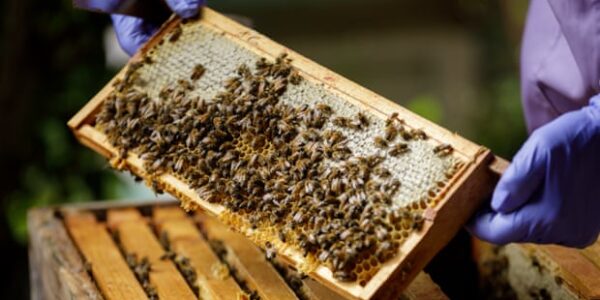
After a long and cold winter that saw two excessive snow falls, we have been enjoying a run of current warm sunny weather with the warmest May on record. Great for UK holiday makers, families and our pollinators. With more people and insects outside we have an increased issue of mis-identification. I am often contacted about bees asking for my help only to find they are bumble bees or solitary bees which I can’t move at all and I’ve also been contacted with perceived sightings of the Asian Hornet – something that would have me shaking in my welly boots! Luckily further investigation has revealed it to be our UK based European Hornet and no where near a worry as it’s Asian counterpart. I therefore thought I’d take some time to answer some bee related curiosities.
All bees, and there are 250 types of bee in the UK will be out foraging for nectar, pollen and water in the sunshine. This means we encounter many more bees and flying insects compared to a dull cloudy day. Bees really are not interested in you or your sweet treat, they really have bumped into you whilst on a flower or water finding trip. With temperatures in the high teens and twenties as they have been recently there are few puddles and random water sources available to bees so bird baths, garden ponds, lakes and rivers become a water source. Any of these in or near your garden will see an increase in the number of insects in your vicinity and they may go off route and find themselves trapped inside your house or conservatory via an open door or window.
If a beekeeper lives within a mile of you, you will also see an increase in honey bees in your garden when the sun is out. Blue/purple flowers are the honey bees favourite but in Spring when there’s not a lot to choose from flowers such as dandelion, daisies and other wild ones which we typically label as weeds make for great forage. Lavender and verbena bushes are also a firm bee favourite and walking past mid-afternoon you may hear the bush buzzing with activity.
A handful of bees getting trapped inside your kitchen or conservatory are not a cause for alarm, it is unlikely a swarm is about to descend on you, more likely you are on a bee flight course and a few have gone off-piste! If however you were to have this sight in your garden, then yes you have a swarm.

I mentioned it above but now I’ll address the Asian Hornet. Media attention has made the public and beekeepers fretful about sightings of the Asian Hornet. It made its way here from Europe last year and is a threat to our honey bees but clear identification is required to prevent invalid reports. Smaller and darker than the European Hornet the following information sheet describes how to identify the Asian Hornet

I hope this article has alleviated some fears regarding bees in houses, conservatories and what a swarm actually looks like as well as the identification of our non-native visitor. Any questions, as always email me [email protected]
Till next time………… x





